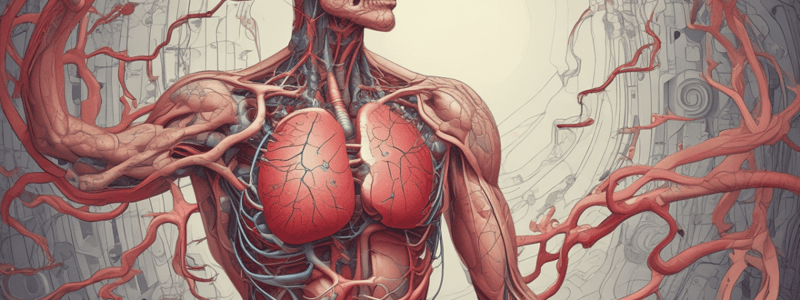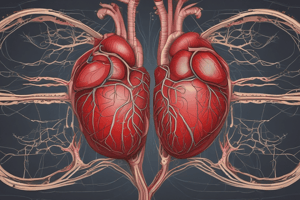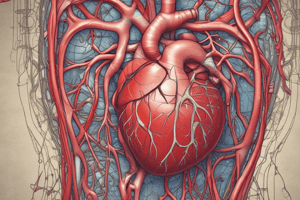Podcast
Questions and Answers
What is the direction of blood flow in the heart?
What is the direction of blood flow in the heart?
- From right atrium to right ventricle, then to the lungs, and finally to the left atrium. (correct)
- From left ventricle to left atrium, then to the lungs, and finally to the right ventricle.
- From left atrium to right ventricle, then to the lungs, and finally to the right atrium.
- From right ventricle to right atrium, then to the lungs, and finally to the left atrium.
What is the main function of the atrioventricular valves?
What is the main function of the atrioventricular valves?
- To prevent blood from flowing backwards (correct)
- To increase the heart rate
- To pump blood from the atria to the ventricles
- To regulate blood pressure in the heart
Which of the following is NOT an atrioventricular valve?
Which of the following is NOT an atrioventricular valve?
- Pulmonary valve (correct)
- Mitral valve
- Aortic valve (correct)
- Tricuspid valve
What prevents the atrioventricular valves from flopping back and forth?
What prevents the atrioventricular valves from flopping back and forth?
What is the function of the papillary muscles?
What is the function of the papillary muscles?
Why is it necessary for the atrioventricular valves to be held in place?
Why is it necessary for the atrioventricular valves to be held in place?
What would happen if the atrioventricular valves were not tethered to the walls?
What would happen if the atrioventricular valves were not tethered to the walls?
What is the purpose of the chordae tendineae lifelines?
What is the purpose of the chordae tendineae lifelines?
What is the first layer that red blood cells encounter when entering the heart chambers?
What is the first layer that red blood cells encounter when entering the heart chambers?
What is the function of the myocardium?
What is the function of the myocardium?
What is the purpose of the pericardium?
What is the purpose of the pericardium?
What is the characteristic of the fluid between the pericardium layers?
What is the characteristic of the fluid between the pericardium layers?
What is the origin of the pericardium?
What is the origin of the pericardium?
What is the inner layer of the pericardium called?
What is the inner layer of the pericardium called?
What is the primary function of the chordae tendineae?
What is the primary function of the chordae tendineae?
What is the outer layer of the pericardium called?
What is the outer layer of the pericardium called?
What is the main function of the endocardium?
What is the main function of the endocardium?
What would happen if a chordae tendinea broke due to the ventricle being too strong?
What would happen if a chordae tendinea broke due to the ventricle being too strong?
What is the difference between the membranous and muscular parts of the interventricular septum?
What is the difference between the membranous and muscular parts of the interventricular septum?
What is the thickness of the endocardium?
What is the thickness of the endocardium?
What is the significance of the myocardium in terms of energy usage?
What is the significance of the myocardium in terms of energy usage?
What is the common birth defect that occurs in the membranous part of the interventricular septum?
What is the common birth defect that occurs in the membranous part of the interventricular septum?
What are the three layers of the heart muscle?
What are the three layers of the heart muscle?
What is the function of the papillary muscles?
What is the function of the papillary muscles?
What is unique about the membranous part of the interventricular septum?
What is unique about the membranous part of the interventricular septum?
What is the endocardium similar to?
What is the endocardium similar to?
What is the purpose of the interventricular septum?
What is the purpose of the interventricular septum?
What would happen if the ventricle was too weak, instead of too strong?
What would happen if the ventricle was too weak, instead of too strong?
What is the name of the layer that is in contact with the heart?
What is the name of the layer that is in contact with the heart?
What does the term 'viscera' refer to in the context of the pericardium?
What does the term 'viscera' refer to in the context of the pericardium?
What is another name for the visceral pericardium?
What is another name for the visceral pericardium?
Which layer of the heart is the outermost?
Which layer of the heart is the outermost?
What are the three main layers of the heart mentioned in the passage?
What are the three main layers of the heart mentioned in the passage?
What is the main difference between the visceral pericardium and the parietal pericardium?
What is the main difference between the visceral pericardium and the parietal pericardium?
Flashcards are hidden until you start studying
Study Notes
Heart Valves
- Atrioventricular valves are between the atria and ventricles, ensuring blood flows in the right direction
- The two atrioventricular valves are the tricuspid valve and mitral valve
- These valves are tethered to the walls, preventing them from flopping back and forth
- Chordae tendineae (cords) and papillary muscles work together to keep the valves from flipping backwards
- The chordae tendineae prevent the valve from flipping backwards, ensuring the ventricles don't screw up the valves
Interventricular Septum
- The interventricular septum is a wall between the ventricles
- The septum has two parts: the membranous part (thin) and the muscular part (thick)
- The membranous part is prone to holes, which can cause blood to flow from the left ventricle to the right ventricle
- This defect is called a VSD (Ventricular Septal Defect)
Heart Wall Layers
- The heart wall has three layers: endocardium, myocardium, and pericardium
- Endocardium:
- A thin layer lining the heart chambers and valves
- Similar to the inner lining of blood vessels
- Red blood cells bump against the endocardium
- Myocardium:
- The thickest layer, making up most of the heart wall
- Contains contractile muscle cells responsible for heart contractions
- Requires oxygen and energy
- Pericardium:
- A thin layer on the outside of the heart
- Has an inner layer (visceral pericardium) and outer layer (parietal pericardium)
- The visceral pericardium is also called the epicardium
Heart Development
- The heart grows from a small fetus heart to an adult heart
- A sac-like structure (pericardium) envelops the growing heart
- The pericardium folds in on itself, creating a gap with fluid between the two layers
Studying That Suits You
Use AI to generate personalized quizzes and flashcards to suit your learning preferences.





